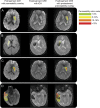Pretreatment blood-brain barrier disruption and post-endovascular intracranial hemorrhage
- PMID: 27316247
- PMCID: PMC4955280
- DOI: 10.1212/WNL.0000000000002862
Pretreatment blood-brain barrier disruption and post-endovascular intracranial hemorrhage
Abstract
Objective: This study sought to confirm the relationship between the degree of blood-brain barrier (BBB) damage and the severity of intracranial hemorrhage (ICH) in a population of patients who received endovascular therapy.
Methods: The degree of BBB disruption on pretreatment MRI scans was analyzed, blinded to follow-up data, in the DEFUSE 2 cohort in which patients had endovascular therapy within 12 hours of stroke onset. BBB disruption was compared with ICH grade previously established by the DEFUSE 2 core lab. A prespecified threshold for predicting parenchymal hematoma (PH) was tested.
Results: Of the 108 patients in the DEFUSE 2 trial, 100 had adequate imaging and outcome data and were included in this study; 24 developed PH. Increasing amounts of BBB disruption on pretreatment MRIs was associated with increasing severity of ICH grade (p = 0.004). BBB disruption on the pretreatment scan was associated with PH (p = 0.020) with an odds ratio for developing PH of 1.69 for each 10% increase in BBB disruption (95% confidence interval 1.09-2.64), although a reliably predictive threshold was not identified.
Conclusions: The amount of BBB disruption on pretreatment MRI is associated with the severity of ICH after acute intervention. This relationship has now been identified in patients receiving IV, endovascular, and combined therapies. Further study is needed to determine its role in guiding treatment.
© 2016 American Academy of Neurology.
Figures


References
-
- Berkhemer OA, Fransen PS, Beumer D, et al. . A randomized trial of intraarterial treatment for acute ischemic stroke. N Engl J Med 2015;372:11–20. - PubMed
-
- Goyal M, Demchuk AM, Menon BK, et al. . Randomized assessment of rapid endovascular treatment of ischemic stroke. N Engl J Med 2015;372:1019–1030. - PubMed
-
- Campbell BC, Mitchell PJ, Kleinig TJ, et al. . Endovascular therapy for ischemic stroke with perfusion-imaging selection. New Engl J Med 2015;372:1009–1030. - PubMed
-
- Jovin TG, Chamorro A, Cobo E, et al. . Thrombectomy within 8 hours after symptom onset in ischemic stroke. N Engl J Med 2015;372:2296–2306. - PubMed
-
- Saver JL, Goyal M, Bonafe A, et al. . Stent-retriever thrombectomy after intravenous t-pa vs. t-pa alone in stroke. N Engl J Med 2015;372:2285–2295. - PubMed
Publication types
MeSH terms
Substances
Grants and funding
LinkOut - more resources
Full Text Sources
Other Literature Sources
Miscellaneous
